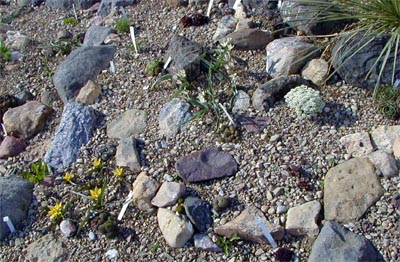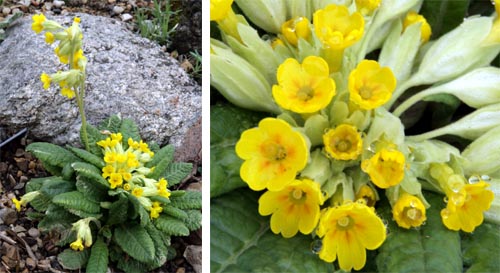
Spring seems to arrive suddenly in Wisconsin. Within a few weeks – or sometimes even days – of the last snowstorm, the earliest spring flowers are blooming. Crocus, winter aconite, species tulips and very early daffodils bloom first, but the next show comes from the small plants amid the boulders in the rock garden. In my yard, the rock garden is one of the first areas perennials start blooming – probably because of the western exposure and the rocks and gravel mulch heat up more quickly than the soil in other areas. The following are some special early-blooming perennials (in April to very early May) in my rock garden, but most are suitable for planting in other types of gardens, too. These are presented in order of their appearance in my garden.
Pulsatilla halleri taurica is a cute little perennial closely related to pasque flower (Pulsatilla vulgaris). This species starts to emerge and bloom slightly before pasque flower in my garden (about the same time as crocus or the earliest daffodils). The extremely fuzzy buds produce light purple flowers on extremely short stems. The finely dissected foliage unfurls fully after bloom. The interesting seed heads can reach 10-12”, while the flowers and foliage remain only about 6” high. This species is hardy to zone 4, and needs well-drained soil.

Draba dedeana is one of about 350 species in this genus in the mustard family (Brassicaceae) primarily native to the northern hemisphere in arctic, sub-arctic, alpine and sub-alpine regions. This small plant from the Pyrenees in Spain forms a dense cushion composed of dark green rosettes of narrow, bristle-tipped, grey-green leaves. The clumps grow moderately quickly, but the plant has a long lifespan. Tiny white flowers on short stems absolutely cover the dome of green foliage, making it look almost like a baseball or softball. The dead flower stalks can be pulled off when dry to improve the appearance of the plant for the rest of the year. This species is one of the best of the white-flowered Drabas (most have yellow flowers). This and most other species of Draba require very well drained soil in full sun, and most do best in lean soil and little fertilizer. It is hardy to zone 4 and is supposedly easily raised from seed.

Primula veris is one of over 400 species in this widely-distributed genus. This species, with several common names including cowslip, English cowslip, and cowslip primrose, is native to temperate Europe and Asia. It is a low growing herbaceous perennial that forms a rosette of dark green, crinkly oval leaves that are covered in velvety hairs.

Clusters of deep yellow, nodding, funnel-shaped flowers are borne on long stems up to 12” tall, with several flower stalks per plant. The flowers are rather fragrant. Rarely red flowers are produced, and there is a variety ‘Sunset Shades’ that consistently has red or orange-red flowers. The Royal Horticultural Society has given it its prestigious Award of Garden Merit (AGM). P. veris does well in sun or partial shade in any fertile, moist, well-drained soil. It naturally grows in well-drained grassy places, fields and woods, so does not have to be restricted to rock gardens. Grow from seed or divide plants in the fall. It is best grown in groups. It is hardy to zone 4.
Aubretia deltoidea, purple rock cress or sometimes called false rock cress, is another member of the mustard family (Brassicaceae) from stony slopes around the Mediterranean. This plant is deer resistant and drought resistant, and is hardy through zone 4. It prefers cool, moist growing conditions, and thrives in rocky or gravelly soil. The gray-green foliage forms a low mat up to 6” high and spreading 18-24” wide. It is not really evergreen, so can look rather pathetic early in the spring. The tiny, diamond-shaped leaves are hairy. The 4-petaled, ¾” wide, star-shaped flowers appear in masses on upright stems. Flowers can be lilac, violet, purple and sometimes red. I have the variety ‘Purple Heart’ which has double, deep purple flowers. The plants look especially nice cascading over a wall or down a slope, or could be used for an edging plant. Shear the plants after blooming to keep compact and divide every three years or so.

Potentilla neumanniana ‘Nana’ (also offered as P. tabernaemontanii and P. verna nana), or creeping cinquefoil, is a low-growing evergreen plant in the rose family (Rosaceae) native to the eastern U.S. with bright yellow buttercup flowers. The deep green leaves look very similar to strawberry leaves, only smaller. It grows only 2-3 inches high, but can spread up to 2 feet (it’s still only about a foot in diameter after several years in my garden). Unlike the related creeping cinquefoil it does not have runners and stays in a clump. It’s great in rock gardens, as a ground cover or between paving stones. It does best in full sun and is hardy in zones 4-8.

– Susan Mahr, University of Wisconsin – Madison





 Aster, Symphyotrichum spp.
Aster, Symphyotrichum spp. Fascinating Fasciation
Fascinating Fasciation Alternatives to Lawn: Groundcovers
Alternatives to Lawn: Groundcovers Marigolds
Marigolds


